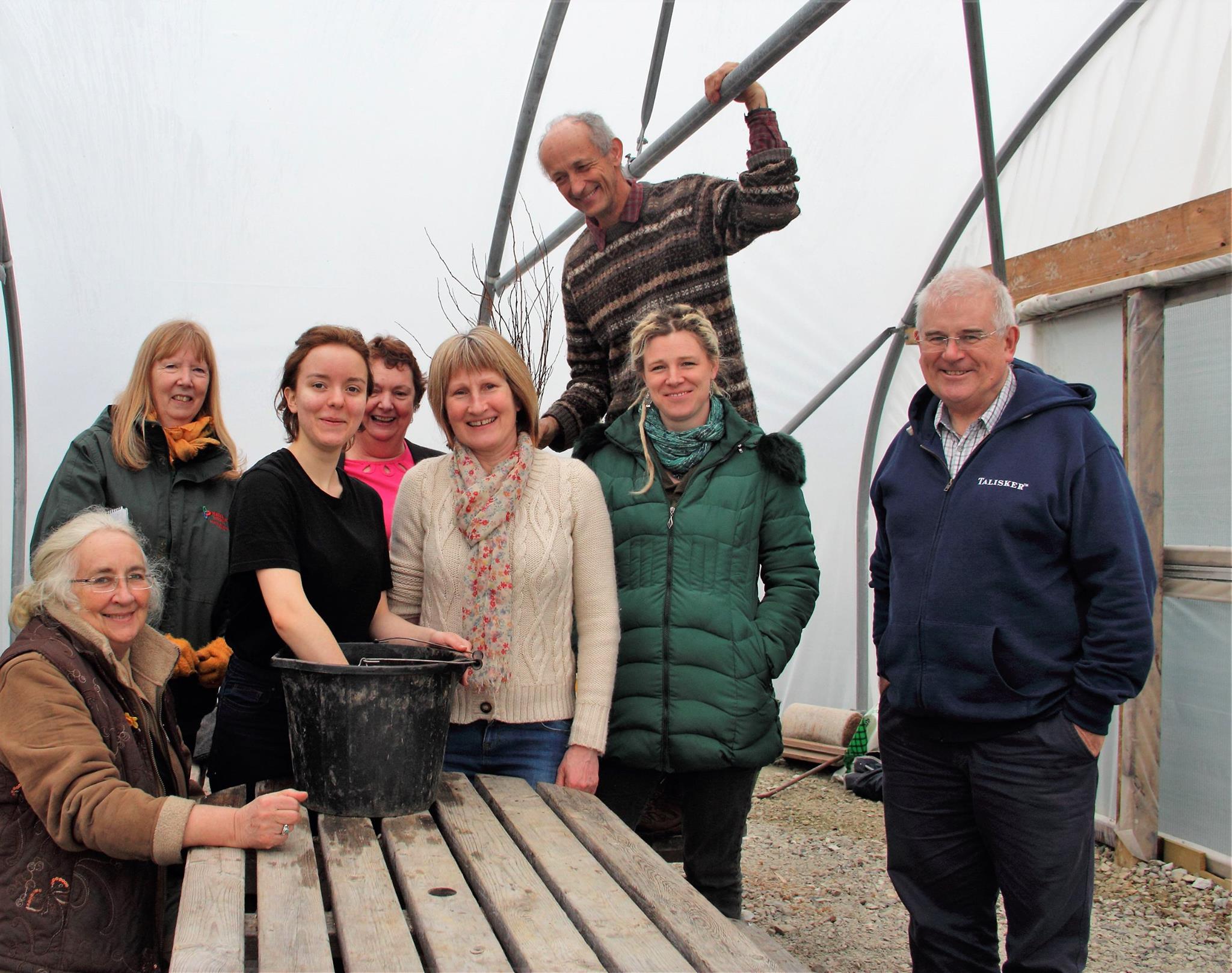Information on the Biodynamic Gardening 2 day course we ran a couple of weeks ago:
Biodynamic agriculture and gardening is recognised throughout the world as a uniquely sustainable organic approach. Based on the principles of ecological self-reliance and diversity, every biodynamic farm seeks as far as possible to sustain fertility using home produced compost and manure and by relying on what it can grow to feed its livestock. In such a closed system each part of the farm cycle is locally adapted and quite naturally precludes the danger of over stocking or monoculture production. The farm is conceived of as an ‘individual organism’ within the whole organism of the planet – which means creating the greatest possible diversity in terms of cropping, habitat provision and landscape features. This ecological foundation provides a good basis upon which to develop a farm community or community supported farm (CSA) – an economy based on the mutual sharing of risks and benefits instead of personal survival.
Speaking at a workshop organised by the Greener Broadford Group within the Broadford and Strath Community Company and held at the Broadford Campus of the West Highland College, UHI on March 10th and 11th 2017, Bernard Jarman, a biodynamic consultant from England, described how reliant we are on the soil and its vitality. He said that a key part of the biodynamic approach involves the use of carefully made biodynamic preparations. “One of these gives growing plants the strength to penetrate the soil and access nutrients that may otherwise be out of reach, while another enhances the plant’s resistance to disease and improves the flavour and quality of the crop. “All life” he said “is dependent on the rhythmic interaction of light and dark, day and night, summer and winter and that where there is life there is rhythm”. This was demonstrated through the hour-long, rhythmic stirring of the ‘cow horn preparation’ and its application on the allotment beds.
He then went on to describe how: “Compost making – the transformation of organic waste materials into living humus – is an art practised by every organic and biodynamic gardener. To enhance and regulate this process and allow the activity of all the necessary plant nutrients to find harmonious and stable expression, a series of six compost preparations made from medicinal plants is applied to the compost. All the preparations are applied in very small amounts and as with homeopathic medicine, it is the dynamic rather than the substance itself which is effective. Biodynamic farmers and gardeners try to work with the active processes in nature”. A special preparation to use as a compost starter and stimulate the formation of humus was made with everyone and interred in a special pit at the Community Allotments for later use.
“Understanding these living processes” he said “also requires knowledge of our cosmic environment” The workshop then explored some key astronomical phenomena – how the sun, moon and planets move and relate to one another against the background of the fixed stars – and how these rhythmic movements influence plant development. The Maria Thun Biodynamic Calendar indicates when particular crops should be sown or harvested. It is based on the moon’s monthly journey through the zodiac and on the particular influences coming from those constellations. Each constellation is connected to one of the elements – earth, water, air, fire – and these in turn to the four parts of the plant – root, leaf, flower, fruit. Sowing a root crop when the moon is in an earth or root constellation will therefore be beneficial. “It is important to remember however” said Bernard “that the soil must be moved to a depth of two or three centimetres if the lunar and planetary influences are to take effect. This means that cultivating and hoeing the soil on particular days is an effective way of engaging lunar influences, especially when a sowing date has been missed.”
In response to questions about common pests and diseases he said: “Most problems in the garden arise because something is out of balance and the challenge is not simply to attack the symptom but to resolve the underlying issue. Aphids for instance come when the plant has suffered a check in its growth and the problem can often be resolved by applying a nettle extract to stimulate sap circulation. Fungal problems often arise around full moon after a period of wet weather. To counteract this, a tea made of the silica-rich horsetail (Equisetum arvense) plant can be applied.”
To conclude the workshop reference was made to research carried out into biodynamic methods, biodynamic plant breeding and community land ownership (see below). Biodynamic agriculture is practised all over the world and biodynamic products are marketed using the internationally recognised Demeter trademark.
The two-day workshop was well supported by residents from across Skye & Lochalsh. BSCC director and one of the attendees on the workshop, Alison MacLennan said, “When I signed up for the course on Biodynamic Gardening, I never imagined for a moment that I was going to be learning about the ruminations of a cow and their importance in preparing healthy food crops for human consumption. This was just one aspect of a very broad ranging subject that gives an insight into the intricate linkages between plant and animal life, the planetary system and the cyclical rhythms influencing all forms of life on earth. Through working with nature, a biodynamic approach to growing provides a refreshingly different perspective on agriculture, nutrition and the quality of the food that we eat. This was a fascinating workshop, delivered by one of the UKs leading specialists on the subject.”
Notes:
- Information about all aspects of biodynamic farming and gardening and a wide range of books can be obtained from Biodynamic Association, Painswick Inn Project, Gloucester Street Stroud GL5 1QG Tel. 01453 759501 email: office@biodynamic.co.uk www.biodynamic.org.uk
- Maria Thun Biodynamic Calendar published by Floris books. Maria Thun was a German farmer who spent her life researching the various moon rhythms, planetary movements and the background star constellations. She conducted thousands of experiments, sowing radishes, beans and other plants during particular constellations. She found time and again that the moon’s position in the zodiac affected how the plants grew. This led to a journey of discovery over 50 years and the publication of her increasingly popular calendar.
- Demeter trademark. Producers selling their products on the open market can be certified as organic and biodynamic by the Biodynamic Association. If they achieve full biodynamic status they can use the Demeter symbol. This serves as a guarantee to consumers that the food has been grown to biodynamic standards. Uniquely among certification bodies Demeter operates throughout the world and is recognised internationally.
- Research. At the Organic Research Institute (FiBl) near Basel, Switzerland a long-term comparison has been carried out (over 22 years) between conventional, organic and biodynamic methods. The biodynamic section shows all round positive results. An increase in soil life and biodiversity was especially marked. Many other pieces of research have been carried into the efficacy of the preparations, food quality and plant health.
- Biodynamic Seeds. A growing range of biodynamic maintained vegetable seed varieties are available through the Biodynamic Seed Cooperative Gosberton Bank Nursery, Gosberton, Spalding, PE11 4PB. 01775 840592 www.seedcooperative.org.uk
- The Biodynamic Land Trust has been set up to obtain land for biodynamic agriculture and to hold it in perpetuity. It is set up as a Community Benefit Society and there are many shareholders who co-own the land. It currently holds land in Sussex, Gloucestershire, Devon and Orkney. www.biodynamiclandtrust.org.uk
- Community Supported Agriculture. A growing movement across the world whereby a community of people support a farm and guarantee to meet its annually budgeted expenses in return for the produce grown. CSA Network communitysupportedagriculture.org.uk

